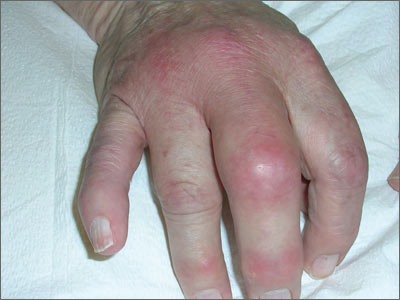User login
The family physician (FP) recognized that this patient was having an attack of gout, which was most likely exacerbated by the new prescription for hydrochlorothiazide. The patient’s serum uric acid level was highly elevated (12.1 mg/dL). No joint aspiration was attempted because the diagnosis was well supported by the history, physical exam, and elevated serum uric acid level.
Crystalline arthritis is caused by the deposition of uric acid crystals (gout) or calcium pyrophosphate dihydrate crystals (calcium pyrophosphate dihydrate crystal deposition disease) resulting in episodic flares with periods of remission.
Treatment for acute cases of gout include nonsteroidal anti-inflammatory drugs (NSAIDs) or colchicine. The treatment of chronic gout includes modifications to diet and existing medications and the lowering of urate levels. Patients are encouraged to:
- reduce the intake of purine-rich foods (eg, organ meats, red meats, and seafood)
- increase fluid intake to 2000 mL/d
- lower alcohol intake
- consume dairy products as these may be protective against gout
- change medications. Specifically, discontinue aspirin and consider stopping a thiazide diuretic. Lower urate levels with xanthine oxidase inhibitors (eg, allopurinol), uricosuric agents (eg, probenecid), or uricase agents (eg, pegloticase).
In this case, the FP replaced the thiazide diuretic with a calcium channel blocker. The patient was treated with colchicine to stop the acute inflammation. He was also told to drink less alcohol (or abstain from it) and to avoid red meat in his diet.
Photo courtesy of Robin Treadwell, MD and text courtesy of Richard P. Usatine, MD. This case was adapted from: Chumley H, Usatine R. Arthritis overview. In: Usatine R, Smith M, Mayeaux EJ, et al, eds. Color Atlas of Family Medicine. 2nd ed. New York, NY: McGraw-Hill; 2013:562-568.
To learn more about the Color Atlas of Family Medicine, see: www.amazon.com/Color-Family-Medicine-Richard-Usatine/dp/0071769641/
You can now get the second edition of the Color Atlas of Family Medicine as an app by clicking on this link: usatinemedia.com
The family physician (FP) recognized that this patient was having an attack of gout, which was most likely exacerbated by the new prescription for hydrochlorothiazide. The patient’s serum uric acid level was highly elevated (12.1 mg/dL). No joint aspiration was attempted because the diagnosis was well supported by the history, physical exam, and elevated serum uric acid level.
Crystalline arthritis is caused by the deposition of uric acid crystals (gout) or calcium pyrophosphate dihydrate crystals (calcium pyrophosphate dihydrate crystal deposition disease) resulting in episodic flares with periods of remission.
Treatment for acute cases of gout include nonsteroidal anti-inflammatory drugs (NSAIDs) or colchicine. The treatment of chronic gout includes modifications to diet and existing medications and the lowering of urate levels. Patients are encouraged to:
- reduce the intake of purine-rich foods (eg, organ meats, red meats, and seafood)
- increase fluid intake to 2000 mL/d
- lower alcohol intake
- consume dairy products as these may be protective against gout
- change medications. Specifically, discontinue aspirin and consider stopping a thiazide diuretic. Lower urate levels with xanthine oxidase inhibitors (eg, allopurinol), uricosuric agents (eg, probenecid), or uricase agents (eg, pegloticase).
In this case, the FP replaced the thiazide diuretic with a calcium channel blocker. The patient was treated with colchicine to stop the acute inflammation. He was also told to drink less alcohol (or abstain from it) and to avoid red meat in his diet.
Photo courtesy of Robin Treadwell, MD and text courtesy of Richard P. Usatine, MD. This case was adapted from: Chumley H, Usatine R. Arthritis overview. In: Usatine R, Smith M, Mayeaux EJ, et al, eds. Color Atlas of Family Medicine. 2nd ed. New York, NY: McGraw-Hill; 2013:562-568.
To learn more about the Color Atlas of Family Medicine, see: www.amazon.com/Color-Family-Medicine-Richard-Usatine/dp/0071769641/
You can now get the second edition of the Color Atlas of Family Medicine as an app by clicking on this link: usatinemedia.com
The family physician (FP) recognized that this patient was having an attack of gout, which was most likely exacerbated by the new prescription for hydrochlorothiazide. The patient’s serum uric acid level was highly elevated (12.1 mg/dL). No joint aspiration was attempted because the diagnosis was well supported by the history, physical exam, and elevated serum uric acid level.
Crystalline arthritis is caused by the deposition of uric acid crystals (gout) or calcium pyrophosphate dihydrate crystals (calcium pyrophosphate dihydrate crystal deposition disease) resulting in episodic flares with periods of remission.
Treatment for acute cases of gout include nonsteroidal anti-inflammatory drugs (NSAIDs) or colchicine. The treatment of chronic gout includes modifications to diet and existing medications and the lowering of urate levels. Patients are encouraged to:
- reduce the intake of purine-rich foods (eg, organ meats, red meats, and seafood)
- increase fluid intake to 2000 mL/d
- lower alcohol intake
- consume dairy products as these may be protective against gout
- change medications. Specifically, discontinue aspirin and consider stopping a thiazide diuretic. Lower urate levels with xanthine oxidase inhibitors (eg, allopurinol), uricosuric agents (eg, probenecid), or uricase agents (eg, pegloticase).
In this case, the FP replaced the thiazide diuretic with a calcium channel blocker. The patient was treated with colchicine to stop the acute inflammation. He was also told to drink less alcohol (or abstain from it) and to avoid red meat in his diet.
Photo courtesy of Robin Treadwell, MD and text courtesy of Richard P. Usatine, MD. This case was adapted from: Chumley H, Usatine R. Arthritis overview. In: Usatine R, Smith M, Mayeaux EJ, et al, eds. Color Atlas of Family Medicine. 2nd ed. New York, NY: McGraw-Hill; 2013:562-568.
To learn more about the Color Atlas of Family Medicine, see: www.amazon.com/Color-Family-Medicine-Richard-Usatine/dp/0071769641/
You can now get the second edition of the Color Atlas of Family Medicine as an app by clicking on this link: usatinemedia.com

